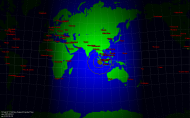Maybe you could learn from something like
Xearth - a rather pretty and unique "screensaver" that can show realtime/live earthquakes from around the globe. Apparently it takes feeds from databases of data accumulated from remote seismic data loggers. You can also look at the data in the application interface.
I haven't used it for a while, but I recall that any tremors were plotted and displayed as little red circular bands - the bigger the tremor on the Richter scale, the bigger the diameter of the band.
The plots were displayed cumulatively, so, a while after starting the thing up, you got a developing picture of recent history which was progressively updated with current event plots. I'm not sure how long (hours/days) the "old" bits of the plots were left to hang around for.
Example: This was 13 Sep. 2007: (The original was a BMP file, and the placenames are legible, but in the smaller .PNG copy they don't look so good.)
 Project Honeynet's HoneyMap displays cyberattacks in real time
Project Honeynet's HoneyMap displays cyberattacks in real timeHere's a .JPG copy from 1st Oct. 2007:
 Project Honeynet's HoneyMap displays cyberattacks in real time
Project Honeynet's HoneyMap displays cyberattacks in real timeI don't know much about how it was developed or what functions it uses though.
Could you crib something from that? Here is an extract from the home page.
What is it?
Xearth sets the X root window to an image of the Earth, as seen from your favorite vantage point in space, correctly shaded for the current position of the Sun. By default, xearth updates the displayed image every five minutes. The time between updates can be changed using either X resource or a command-line option. Xearth can also be configured to either create and render into its own top-level X window or render directly into PPM or GIF files; see the man page for details.
New features
Version 1.1 of xearth includes several new features:
new position specifier (moon)
new rotation specifier (galactic)
cylindrical projections (-proj cyl)
support for "real" 24-bit displays
support for running xearth it its own top-level window (-noroot, -geometry)
Information about previous versions can be found in the HISTORY file that ships with the version 1.1 sources.
